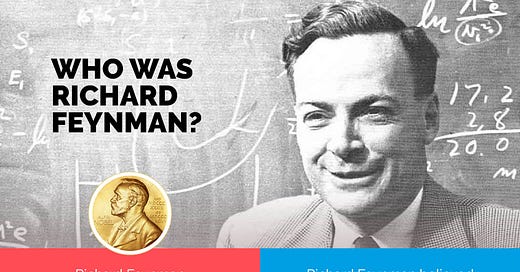When asked for my hero, the answers differ as an adult. No longer Don Mattingly, the New York Yankees captain and first baseman. No longer Pink Floyd, and their mastery of the rock opera. It is Richard Feynman.
An Uber-Perfunctory Biography
Feynman was not your typical physicist. He was a safecracker, painter, bongo player, and raconteur. He was known for his eccentricities as much as his science.
During his time at Los Alamos working on the Manhattan Project, Feynman took up lock picking and safe cracking, much to the chagrin of security officers. He would leave cheeky notes in the safes of his colleagues, just to let them know their "secure" documents weren't so secure after all.
Feynman was an avid bongo player. Often seen drumming on the tables in the cafeteria at Caltech. He even participated in an offbeat ballet, playing his bongos while a ballerina danced to his beats.
Feynman was a great communicator. His ability to break down complex scientific concepts into understandable, relatable ideas was unparalleled. But perhaps the most remarkable thing about Feynman was his relentless curiosity. He once said, "I have approximate answers and possible beliefs and different degrees of certainty about different things, but I'm not absolutely sure of anything." (Learn more in his “adventures of a curious character” here).
In a nutshell, Feynman was a polymath. His contributions to science, his unique approach to teaching and learning, and his zest make him someone worth emulating.
The Secret Class
He also ran a class at Cornell called Physics X. This was academia's secret menu item. No registration, just show up if you're a physics enthusiast. The happenings of those classes in Olin Hall's basement? Shrouded in mystery. But, several physicists swear it was the golden ticket in their education. And a bunch of those volunteer students? They went on to win Nobel Prizes. When I heard about that class, I was hooked. For over two decades, I've been running my own encore in every course I teach, dubbed Psychology X. It's an open mic night where students can ask me anything.
The 5-Part Learning Technique
Feynman was a big believer in understanding over memorization. He'd say, "You don't know something until you've taught it to a child." That's the essence of his technique. It's about breaking down complex ideas into their simplest form. It's about teaching, not regurgitating.
Here's how it works:
Choose a concept you want to understand. It could be anything. Quantum physics, the enduring impact of Greek Mythology, why your dog keeps chewing your shoes. The key is to start with a clear question or concept you're curious about. Write it down. Make it real.
Teach it to a child. Not literally, unless you have a very patient child on hand. But imagine you're explaining the concept to a 12-year-old. Break it down. Use simple language. Ditch the jargon. Draw a picture or a diagram if it helps. The goal is to translate the concept into plain English.
Identify gaps in your explanation. Where did you stumble? What couldn't you explain simply? That's where your understanding is lacking. These gaps are your guide. They show you where you need to dig deeper.
Review and simplify. Go back to your sources. Fill in the gaps. Then, simplify some more. Rinse and repeat until you can explain the concept in its simplest form. This step is crucial. It's where the real learning happens. It's where you move from memorization to understanding.
Test your knowledge. Try explaining the concept to a friend, a family member, or even a captive capybara at the zoo. Can you do it without looking at your notes? Can you answer questions about it? If you can, you've mastered the Feynman Technique.
It's not about being smart. It's about being clear. It's about truly understanding. And who knows, maybe it'll be your golden ticket to new skills and creative products.
If you want to meet for an individual meeting about anything including science, writing, well-being, college, mentoring, consultation, or life advice, Click Here to Sign Up.
Dr. Todd B. Kashdan is an author of several books including The Art of Insubordination: How to Dissent and Defy Effectively (Avery/Penguin) and Professor of Psychology and Leader of The Well-Being Laboratory at George Mason University.
Follow me on socials: Twitter or Facebook or LinkedIn or Instagram
Read Past Issues Here Including:
Two Podcast Episodes: A Case for Supporting Dissent (and Not Just Diversity)
The reason that I talk to leaders is in hopes of dispelling myths about dissent and disagreement. Because there is such a negative connotation that comes with speaking up at work. There are better ways to handle people that hold minority views. There are better ways to amplify ideas that lack sufficient support because they haven’t been tried before.




